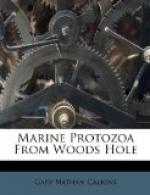Family LICHNOPHORIDAE.
61. Lichnophora macfarlandi Stevens.
Family VORTICELLIDAE.
62. Vorticella marina Greeff.
63. Vorticella patellina Mueller.
64. Zoothamnium elegans D’Udek.
65. Cothurnia crystallina Ehr.
66. Cothurnia nodosa Cl. & Lach.
67. Cothurnia imberbis Ehr.
Subclass SUCTORIA.
Family PODOPHRYIDAE.
68. Podophrya gracilis, n. sp.
69. Ephelota coronata Wright.
Family ACINETIDAE.
70. Acineta divisa Fraip.
71. Acineta tuberosa Ehr.
Family DENDROSOMIDAE.
72. Trichophrya salparum Entz.
* This classification includes only the orders and
families
represented at Woods Hole
Genus AMOEBA Auct.
The pseudopodia are lobose, sometimes absent, the body then progressing by a flowing movement; the body consists of ectoplasm and endoplasm, the latter being granular and internal, the former hyaline and external. There is always one nucleus and one vacuole, but both may be more numerous. Reproduction takes place by division or by spore-formation. Fresh-water and marine.
Amoeba guttala Duj. Fig. 1.
A minute form without pseudopodial processes, extremely hyaline in appearance, and characterized by rapid flowing in one direction. The body is club-shape and moves with the swollen end in advance. A comparatively small number of large granules are found in the swollen portion, while the smaller posterior end is quite hyaline. Contractile vacuole absent, and a nucleus was not seen. Frequent in decomposing vegetable matter. Length 37 mu. Traverses a distance of 160 mu in one minute.
The fresh-water form of A. guttula has a vacuole,
otherwise
Dujardin’s description agrees perfectly with
the Woods Hole forms.
[Illustration: Fig. 1.—Amoeba guttala.]
Amoeba? Fig. 2.
A more sluggish form than the preceding, distinguished by its larger size, its dense granulation, and by short, rounded pseudopodia, which, as in Amoeba proteus, may come from any part of the body. A delicate layer of ectoplasm surrounds the granular endoplasm, and pseudopodia formation is eruptive, beginning with the accumulation of ectoplasm. Movement rapid, usually in one direction, but may be backwards or sideways, etc. Contractile vacuole absent; the nucleus is spherical and contains many large chromatin granules. Length 80 mu; diameter 56 mu.
[Illustration: Fig. 2.—Amoeba sp.]
Genus TRICHOSPHAERIUM Schneider ’78
Synonym: Pachymyxa hystrix Gruber.




